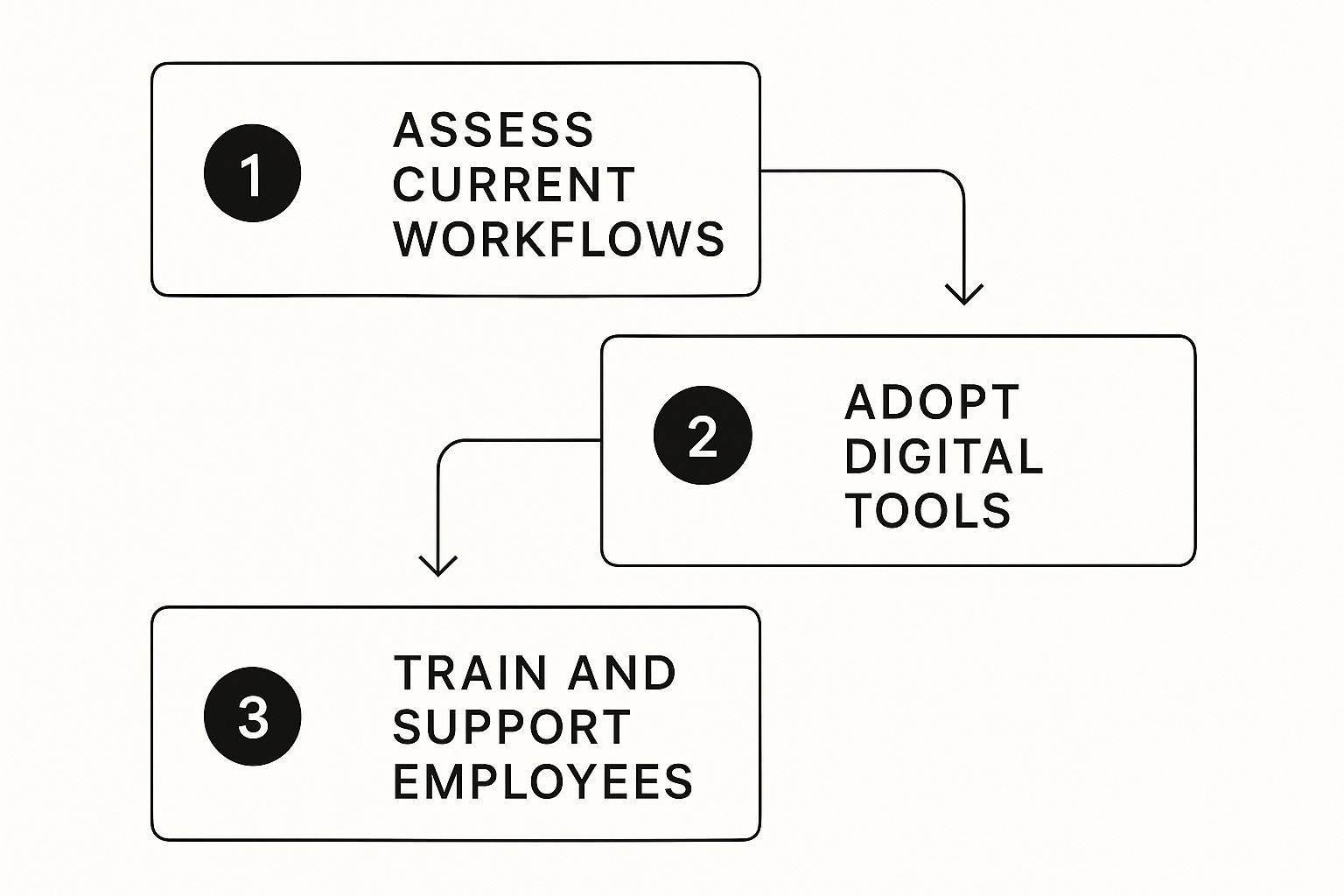Understanding What Digital Transformation Really Means
The term digital transformation often sounds more complicated than it is, bringing to mind complex charts and technical jargon. At its heart, the concept is quite simple. Think of it like a major home renovation. You’re not just adding a new smart speaker to the living room; you’re knocking down walls for an open-plan space, rewiring the whole house for modern appliances, and rerouting plumbing for better flow. The goal isn't just to add gadgets, but to change how your home functions to make life better.
For a small business, the same idea holds true. A real small business digital transformation isn't about just buying the newest software or starting a social media page. It's a deeper, more strategic change in how you do business. It means rethinking your core processes and using technology to connect them in smarter ways.
Beyond Buzzwords: A Shift in Mindset
Digital transformation is fundamentally a cultural and operational adjustment, with technology playing a supporting role. It involves moving away from isolated, often manual or paper-based tasks, and toward an integrated system where information flows freely. This shift helps different parts of your business—from customer service and sales to inventory and invoicing—communicate without friction.
Imagine a local bakery that traditionally took phone orders in a paper notebook. A digital approach would involve an online ordering system that automatically updates the kitchen’s display, adjusts ingredient inventory, and sends a confirmation text to the customer. This isn’t just a new tool; it’s a completely new, more efficient way of working that benefits both the staff and the customer.
The chart below highlights key technology trends that make these kinds of deep changes possible for businesses of any size.
As the data from McKinsey shows, applied AI and the wider use of machine learning are leading the way. This points to a major shift toward more intelligent and automated business processes, moving beyond basic digitization to build smarter, data-informed operations.
What Does This Look Like in Practice?
Digital transformation shows up in different ways, but it usually focuses on three main areas:
- Improving the Customer Experience: Using digital tools to make every interaction with your customers smoother, quicker, and more personal.
- Optimizing Operations: Automating repetitive jobs, improving team communication, and using data to make smarter decisions.
- Creating New Business Models: Finding new sources of income or services that are only possible with digital technology.
This isn't a far-off idea; it's happening right now. By 2025, an estimated 70% of small and medium-sized businesses are expected to significantly change their operations by adopting digital tools. This broad movement includes integrating technologies like cloud computing and AI to work more efficiently and create better customer interactions. To get a clearer idea of this trend, you can find more information on how SMBs are preparing to adapt and thrive with digital strategies. Ultimately, it’s about reshaping your business for the modern market—not just to keep up, but to secure a real competitive advantage.
Why Waiting Is The Riskiest Move You Can Make
 The old saying "if it ain't broke, don't fix it" no longer applies to running a business. In today’s market, choosing to do nothing is a strategic decision—and it's often the most dangerous one. While your current methods might feel comfortable, your competitors are adopting digital tools that help them work faster, make smarter decisions, and understand their customers on a deeper level. This isn't just about missing an opportunity; it's about steadily falling behind.
The old saying "if it ain't broke, don't fix it" no longer applies to running a business. In today’s market, choosing to do nothing is a strategic decision—and it's often the most dangerous one. While your current methods might feel comfortable, your competitors are adopting digital tools that help them work faster, make smarter decisions, and understand their customers on a deeper level. This isn't just about missing an opportunity; it's about steadily falling behind.
Waiting to act creates a competitive gap that only gets harder to close. Early adopters of small business digital transformation aren't just getting a temporary leg up; they're building entirely new operational strengths. They are learning to use data to guide their choices, automating repetitive work to free up their teams for more important tasks, and creating customer experiences that build lasting loyalty. Every month you delay, they pull further ahead, refining their operations and capturing a share of the market you might never win back.
The New Competitive Arena
Digital tools are changing the rules of the game. Not long ago, sophisticated systems for customer management or data analysis were only accessible to large corporations with deep pockets. Now, affordable and easy-to-use solutions give small businesses the same powerful abilities. This shift has changed what it means to compete. It’s no longer about who is biggest, but who is most agile and operates most intelligently.
This newfound access means your local rival could be using an AI-powered scheduling tool to optimize their delivery routes, saving on fuel and time. Or they might be using a cloud-based inventory system to prevent running out of popular items. Exploring the top benefits of cloud computing for startups and SMEs highlights just how much potential is available.
To see this difference in action, let’s compare the old way of doing things with the new, digital approach. The table below breaks down how day-to-day operations can be completely changed.
Digital vs Traditional Business Operations Comparison
A detailed comparison showing the differences between traditional business operations and digitally transformed processes across key areas like customer service, inventory management, and financial tracking
As the table shows, these aren't small adjustments. They are fundamental improvements that directly boost efficiency and profitability. Delaying your own digital transformation essentially means choosing the slower, more expensive path while your competition speeds past you. The perceived risks of making a change—like cost or complexity—are now much smaller than the certain risk of being left behind.
The Technology Stack That Actually Delivers Results
 Choosing the right tools for a small business digital transformation can feel like navigating a maze. The secret isn't to grab every shiny new piece of software but to build a focused technology stack that delivers real results. A smart stack rests on a few essential pillars: cloud infrastructure, customer relationship management, and intelligent automation.
Choosing the right tools for a small business digital transformation can feel like navigating a maze. The secret isn't to grab every shiny new piece of software but to build a focused technology stack that delivers real results. A smart stack rests on a few essential pillars: cloud infrastructure, customer relationship management, and intelligent automation.
Each part should solve a specific problem, from reducing IT headaches to turning first-time buyers into loyal advocates. The objective is to create a connected system where every tool makes the others more powerful.
Building Stronger Customer Connections with CRM
At the center of any customer-focused business is a solid Customer Relationship Management (CRM) system. A CRM is much more than a digital contact list; it’s the central hub for every single customer interaction. Think of it as your business’s shared memory, giving every team member the complete story they need to provide fantastic service.
- Centralized Information: A good CRM tracks every email, phone call, purchase, and support ticket, offering a complete picture of each customer's journey.
- Personalized Marketing: It helps you segment your audience to send targeted messages, making your marketing more relevant and effective.
- Improved Sales Process: Sales teams can manage leads, follow opportunities, and predict revenue with far greater accuracy.
The screenshot above from Salesforce shows how a CRM dashboard provides a clear overview of sales activities and customer data. This unified view helps businesses shift from simply reacting to problems to proactively building relationships—a key ingredient for long-term success.
Unlocking Efficiency Through Automation and AI
Another critical piece of your technology stack is tools that enable business process automation. Many routine, time-consuming tasks can be handled by software, which frees up your team to concentrate on more important, strategic work. You can explore many practical business process automation examples to see how this works in the real world.
This is also where Artificial Intelligence (AI) makes a huge impact. AI is quickly becoming essential for small businesses everywhere. A recent survey showed that nearly 80% of small businesses are already using AI or planning to adopt it. AI is excellent at automating repetitive jobs like payroll and inventory management, but it also provides advanced insights, like spotting patterns to predict future trends. Businesses are increasingly investing in digital transformation for growth by using these very tools.
Embracing the Flexibility of the Cloud
Supporting both CRM and automation is the move to cloud computing. For a small business, this is a massive advantage. Instead of buying and maintaining expensive servers in your office, you can access powerful software and data storage right over the internet. This approach offers several clear benefits:
- Reduced Costs: You skip the large upfront expense for hardware and instead pay a predictable monthly or yearly fee.
- Scalability: Cloud services grow with your business. You only pay for what you use, when you use it.
- Accessibility: Your team can get to essential data and software from anywhere with an internet connection, allowing for flexible and remote work.
Building a technology stack with these three pillars—CRM, automation, and the cloud—creates a powerful foundation for growth. It helps you work smarter, understand your customers on a deeper level, and respond quickly to changes in the market.
Navigating The Obstacles Everyone Faces
Taking the leap into small business digital transformation is an exciting move, but it's a path that often comes with a few hurdles. Knowing what these common challenges are ahead of time lets you prepare for them, turning potential roadblocks into manageable steps. The biggest obstacles aren't always technical—they frequently involve people, budgets, and existing ways of working.
One of the first challenges many business owners face is budget. Enterprise-level solutions can come with a massive price tag, but the modern market is full of affordable, scalable tools built specifically for small businesses. The trick is to start with a clear budget and prioritize investments that offer the most immediate improvement to your operations or customer happiness, instead of trying to change everything at once.
Overcoming Internal Resistance
Aside from money, resistance from your team is another common speed bump. Change can feel uncomfortable, and employees who are used to established routines might push back against new technology. This hesitation often stems from a fear of the unknown or the worry that new systems will be hard to learn.
The best way to handle this is with open communication and thorough training. Explain why a change is happening and how it will actually make daily work easier, not more complicated. For example, introducing a new communication tool like Nora, which allows technicians to send job notes through WhatsApp, makes their workflow simpler by cutting out manual data entry. You can learn more about how Nora uses AI to organize job notes. By showing these direct benefits, you can build support instead of facing opposition.
Choosing the Right Partners and Tools
Picking the wrong technology is an expensive mistake that can set you back. Many business owners are sold on complex software that doesn't work well with their other systems or is just too confusing for their team to use. This creates a new problem: if a tool can't connect with others, it forces employees to enter the same information in multiple places, creating more work.
To prevent this, make a checklist of your "must-have" features before you even look at vendors. Does this new software connect with your accounting or scheduling programs? Is the company's support team helpful and easy to reach?
To help you get ahead of these issues, we've put together a table that breaks down the most frequent challenges small businesses encounter, along with practical ways to solve them.
Common Digital Transformation Challenges and Solutions
A comprehensive breakdown of the most frequent obstacles small businesses face during digital transformation, along with proven solutions and prevention strategies.
Getting past these obstacles is all about proactive planning, not just putting out fires. By anticipating budget needs, addressing employee concerns directly, and carefully vetting your technology, you can ensure your digital transformation stays on course and delivers genuine value to your business.
Your Practical Implementation Roadmap
Big changes don't happen all at once. Approaching your small business digital transformation without a plan is like building a house without blueprints. A clear roadmap breaks the process into manageable phases, which keeps things from getting too complex and helps you avoid expensive mistakes. This framework allows you to build a solid foundation before adding more advanced, customer-facing improvements and automation.
The following infographic shows the basic, three-step cycle for any successful digital implementation.

This visual highlights that adopting new digital tools is a continuous loop of review, action, and support, not just a one-and-done project.
Phase 1: Assess and Prioritize
The first step is to take an honest look at your current operations. Before you can improve anything, you need to understand where the real slowdowns are. Ask your team and yourself a few important questions:
- Which daily tasks take up the most time for the least reward?
- Where does information get lost between your team in the field and the office?
- What part of your customer service process creates the most frustration for everyone?
Your answers will point to the areas where change will have the biggest impact. For example, if your technicians spend hours at the end of the day writing up job notes, a tool that automates that task should be a high priority. This assessment helps you spend your budget on solving real problems instead of just chasing the latest technology.
Phase 2: Select and Implement Foundational Tools
Once you know your priorities, you can begin picking the right tools. Start with foundational software that can grow with your business. Many small businesses start with a cloud-based productivity suite that offers secure email, file storage, and shared documents.
For example, a common choice like Microsoft 365 offers core applications like Word, Excel, and Teams. Bundled solutions like these provide a cost-effective way to centralize how your team communicates and manages data. After this foundation is solid, you can add more specialized software, like a CRM or an accounting program. As you map out your plan, think about how to improve your website's reach with strategies like SEO for small businesses to bring in more customers.
Phase 3: Train, Get Feedback, and Refine
New technology is only useful if your team knows how to use it properly. The last, and perhaps most critical, phase is all about training and ongoing support. Rushing this part is a sure way to fail.
- Plan for training: Set aside specific time for hands-on training. Don’t expect your team to learn a new system during their already busy workday.
- Create champions: Find a few tech-savvy team members who can become the go-to experts for their colleagues.
- Establish a feedback loop: Regularly ask your team what’s working and what isn’t. Use their input to adjust processes. If a new tool is causing more problems than it solves, it’s not the right fit.
This roadmap is a cycle. As your business changes, you’ll go back to the assessment phase, find new opportunities for improvement, and continue to update your digital tools. This iterative process ensures your digital transformation stays aligned with your real-world business needs and delivers value for the long term.
Measuring Success And Maximizing Your Investment
A small business digital transformation is a serious commitment of time, money, and effort. Like any major business decision, you need a clear way to measure its impact. Simply adopting new tools isn't the goal; the objective is to see tangible improvements in your operations and, ultimately, your bottom line. Tracking your performance allows you to understand what's working, what isn't, and how to get the most out of every dollar you spend. It’s the difference between guessing and knowing.
Before you introduce any new systems, it's essential to establish a baseline. What are your current numbers? Knowing your starting point is the only way to accurately measure how far you've come. Think of it like a "before" picture for a home renovation. If you want to speed up your billing cycle, you first need to calculate your average time-to-invoice before implementing a new tool. Without this initial data, you can't prove that your investment delivered a real return.
Key Metrics That Matter
It's easy to get lost in a sea of data. Experienced business owners focus on a handful of key performance indicators (KPIs) that directly reflect business health, rather than chasing vanity metrics like social media likes. The right metrics show how your digital changes are affecting operations, customer happiness, and finances.
Here are the types of metrics successful businesses prioritize:
- Operational Efficiency: This measures how much time and effort your team is saving. Key metrics include time saved per task, reduction in manual errors, and faster project completion times. For example, if your technicians use an AI tool like Nora to automate job notes, you can track the reduction in time spent on end-of-day paperwork.
- Customer Satisfaction: Happy customers become repeat customers. You can measure this through metrics like customer lifetime value (CLV), Net Promoter Score (NPS), and a reduction in customer support tickets. A smoother digital experience often leads to measurable gains in loyalty.
- Financial Performance: Ultimately, every change should connect back to financial results. Track metrics like an increase in revenue, improved profit margins, and a shorter sales cycle. For instance, achieving a 20% reduction in the time it takes to send an invoice directly improves your cash flow.
To make tracking these improvements easier, it helps to organize your metrics by business function. A structured approach ensures you're measuring what matters across the entire company.
This table provides a clear roadmap for what to track, how to measure it, and what goals to aim for. The key insight is that each metric connects a digital tool or process change to a concrete business outcome.
Turning Data Into Decisions
Gathering data is only half the battle. The next step is using that information to make smarter decisions about your future technology investments. Regular reviews of your KPIs will show which tools provide a strong return on investment (ROI) and which might need rethinking.
For instance, if you notice your operational efficiency metrics have stalled, it might be time to look for bottlenecks in your new workflow or provide additional training for your team. This data-backed approach helps you communicate the value of your digital strategy to your team and other stakeholders. It proves that digital transformation isn't just an expense—it's a direct driver of business growth. By focusing on these core metrics, you can ensure your investment continues to pay dividends long after the initial implementation.
Building A Future-Ready Business Strategy

Because business technology moves so quickly, a rigid plan for your small business digital transformation can feel obsolete the moment it's finished. The real goal isn't to predict the future with perfect accuracy but to build a business that is ready for whatever comes next. Think of it like constructing a ship. You can't control the weather, but you can build a vessel that is sturdy enough for rough seas and nimble enough to change course when a storm appears.
This kind of adaptability begins with the decisions you make today. Successful small businesses build flexibility directly into their digital foundations. This often means choosing tools and software that can grow with them, also known as scalable solutions. A scalable system doesn't demand a complete, costly replacement when your business doubles in size or adds a new service. It simply expands with you, making sure your initial investment keeps delivering value.
Staying Ahead of the Curve Without Getting Overwhelmed
Keeping up with every new technology can feel like a full-time job. The good news is you don't have to be an expert on everything. Instead, focus on understanding a few important shifts that will almost certainly affect how you do business. Smart business owners are preparing for these changes now, getting a head start while others wait.
Here are a few major trends to keep on your radar:
- The Rise of Intelligent Automation: This is more than just basic automation. It involves using AI to manage complex, dynamic tasks. For instance, an AI assistant could listen to a technician's voice notes, ask for more detail if something is unclear, and then format the information perfectly for an invoice without any manual data entry.
- A Mobile-First World: A growing number of customer interactions, from finding your business to making a payment, now happen on smartphones. Your digital tools, from your website to your communication apps, need to offer a smooth and simple experience on a mobile device.
- Increasing Focus on Data Privacy: Customers are more conscious of how their data is being used, and privacy rules are getting tighter. Businesses that are open and responsible with customer information will build trust, which is a significant competitive advantage.
This focus isn't just a short-lived fad; it represents a fundamental shift. The search data below shows the steady and growing interest in "small business digital transformation" over the last five years.

This graph from Google Trends confirms that this is a long-term change in how companies operate, not just a temporary buzzword.
Cultivating a Culture of Continuous Improvement
Perhaps the most crucial part of a future-ready strategy is fostering a culture where your team is always looking for better ways to work. This doesn't mean making huge changes every month. It’s about encouraging small, consistent improvements. When your team feels comfortable suggesting new ideas or pointing out problems, your business naturally adapts and becomes stronger over time.
This kind of culture makes bringing in new technology much easier. When your team is already accustomed to improving processes, a new tool isn't seen as a problem but as the next logical step forward. The goal is to make adaptation a regular part of your business rhythm. This keeps you ahead of competitors while you focus on what truly matters: providing great service and growing your business.
Ready to build a future-ready strategy for your field service operations? Discover how Nora, the AI assistant from ResQ, uses simple WhatsApp messages to automate job notes, eliminate manual data entry, and connect your field and office teams instantly.



